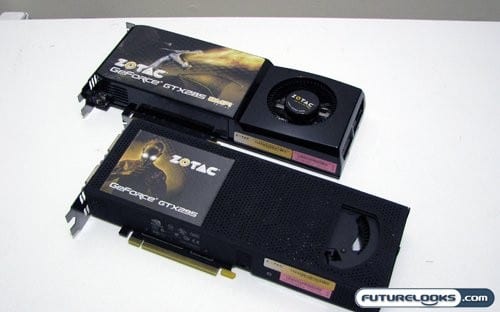Test System Setup

To test the ZOTAC GeForce GTX 285 AMP! Edition and the ZOTAC GeForce GTX 295 we installed them in the following test system made up of the following components:
- AMD Phenom 9850 2.5GHz Quad Core CPU
- Asus M3A32-MVP Deluxe/WiFi-AP 790FX Motherboard
- Corsair Dominator DDR2 4GB PC2-8500 RAM Kit
- Western Digital VelociRaptor 300GB 10000rpm SATA2 Hard Drive
- GELID Silent Spirit Quad Heatpipe CPU Cooler
- Antec Skeleton Open Air Computer Case
- Thermaltake Toughpower 1000W Power Supply
- Microsoft Windows Vista Ultimate SP1 64-bit
We used a rather large suite of software for testing purposes. First we did a couple run-throughs in 3DMark Vantage to see how the card performed in synthetic testing. Though 3DMark Vantage uses a game engine to test things, the engine used is developed by Futuremark themselves and isn’t used in any real world games. At least not yet. But if the engine does get the game title treatment, then all the better.
For real world testing, we used a selection of modern and popular titles to put the cards through their paces. In other words, we chose stuff the people actually play. Obviously, we buy cards to play games, not to benchmark. Those titles include Crysis, World in Conflict, Unreal Tournament 3, and Half Life 2: Episode 2. So without further adieu, here’s how things went down.
3DMark Vantage
3DMark offers a series of preset benchmark runs that gradually increase resolution and display settings to further and further push the hardware being tested. For the purpose of testing these high end cards, we only decided to use the “High” and “Extreme” test settings. The reason for this is because these two settings use resolutions of 1680×1050 and 1920×1200 respectively, and these are the two most widely used resolutions on most modern LCD panels.

We start with the “High” test preset. Though I was hoping things would actually turn out as one would expect, it didn’t quite go that way. Most of the literature out there indicates that there is only a 10% performance boost in going from the GTX 280 to the GTX 285. This is due to the die shrink of the GPU in the newer card, which allows for cooler running temperatures and slightly higher speeds over its older counterpart. So why the nearly 40% jump in performance? Well I was having some issues with running the benchmark using the new drivers that came with the card. I have updated the drivers now, and the problem has been corrected, but I was unable to post the results for this test.

Luckily the tests we ran in the “Extreme” mode were done with the new drivers, and they managed to redeem themselves with the results posted. The increase in performance from the GTX 280 to the GTX 285 was only 8%, which is just shy of the prescribed 10%, but that extra ground should be gained in the real world tests. As for the GTX 295 it was light years ahead of the other cards, relatively speaking. The GTX 295 beat the GTX 285 by a margin of about 29%. Hopefully these results carry over into the real world game tests we have lined up.
